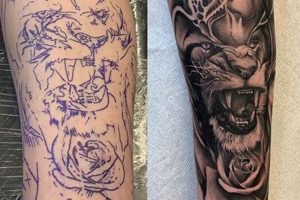Tattoos inspired by Stoicism often incorporate visual representations of core tenets of this ancient philosophy. These designs can range from symbolic imagery such as the Stoic virtues of wisdom, justice, courage, and temperance, to quotes from prominent Stoic figures like Marcus Aurelius, Epictetus, and Seneca. A depiction of a Spartan helmet, for example, might symbolize discipline and resilience, while a quote about accepting what is beyond one’s control could represent acceptance and inner peace.
Choosing a design grounded in Stoic principles can offer a constant visual reminder of one’s commitment to living a virtuous life. These permanent markings can serve as a source of strength and motivation, encouraging reflection on philosophical ideals in daily life. Stoicism, as a philosophy emphasizing reason, virtue, and living in harmony with nature, has resonated with individuals across centuries and cultures. The resurgence of interest in this school of thought is reflected in the growing popularity of related body art.
Further exploration will delve into specific design elements commonly associated with this philosophical tradition, offering a wider selection of inspiration and considering the practical aspects of choosing and implementing such a meaningful tattoo.
1. Virtue
Central to Stoic philosophy, virtue represents the sole good and the path to eudaimonia, often translated as flourishing or a life well-lived. Within the context of body art inspired by Stoicism, representations of virtue serve as potent reminders of this fundamental principle. Exploring its four cardinal facets provides a framework for understanding its significance in design choices.
- Wisdom
Practical wisdom, or phronesis, guides sound judgment and decision-making. It involves understanding the world and acting in accordance with reason. Tattoo designs might incorporate imagery symbolizing wisdom, such as an owl or a key, or utilize quotes emphasizing reasoned action. These serve as visual cues for continuous self-reflection and the pursuit of wisdom.
- Justice
Justice, or dikaiosyne, emphasizes fairness and righteousness in all actions. It involves treating others with respect and upholding moral principles. Scales, a sword, or a straight line can symbolize justice in tattoo designs. These symbols can represent a commitment to acting with integrity and upholding ethical principles.
- Courage
Courage, or andreia, encompasses both physical and moral fortitude. It involves facing adversity with resilience and upholding one’s convictions. A lion, a Spartan helmet, or a depiction of a challenging climb could represent courage visually. Such symbols offer a source of strength and a reminder to persevere in the face of difficulties.
- Temperance
Temperance, or sophrosyne, signifies moderation and self-control. It involves managing one’s desires and emotions in a balanced and reasoned manner. A depiction of an anchor, a balanced scale, or a serene face could symbolize temperance. These visual cues can encourage mindful living and a balanced approach to life’s challenges.
Incorporating these facets of virtue into tattoo designs provides a framework for personalized, meaningful body art reflective of Stoic principles. These visual representations serve not merely as aesthetic embellishments, but as enduring reminders of the continuous pursuit of a virtuous life. They offer a tangible connection to the core tenets of Stoicism, guiding individuals towards a life of wisdom, justice, courage, and temperance.
2. Reason
Reason, or logos, stands as a cornerstone of Stoic philosophy. It represents the principle of order and intelligence that governs the universe and provides a framework for human understanding. Within the context of Stoic-inspired tattoos, reason symbolizes the importance of clear thinking, logical decision-making, and living in accordance with nature’s rational order. This connection manifests in design choices that emphasize clarity, structure, and intellectual engagement. Geometric patterns, for instance, can represent the inherent order and logic valued by Stoics. The spiral, a recurring motif in nature, can symbolize growth and expansion guided by reason. Similarly, a labyrinth can represent the journey of life navigated through rational thought and careful consideration.
Choosing a tattoo that embodies reason offers more than just aesthetic appeal. It serves as a constant reminder of the importance of critical thinking in navigating life’s complexities. The act of permanently inscribing such a symbol on one’s body reinforces the commitment to living a life guided by logic and understanding. For example, a tattoo featuring the Greek letter lambda (), sometimes associated with logic, can serve as a personal emblem of dedication to reasoned thought. A depiction of the Tree of Life, with its intricate branches and roots, can symbolize the interconnectedness of knowledge and the pursuit of wisdom through rational inquiry. Even a simple, minimalist design can convey the essence of reason through its clean lines and balanced composition.
Integrating the principle of reason into tattoo design allows for a deeper engagement with Stoic philosophy. These visual representations serve as powerful reminders of the importance of intellectual clarity and the pursuit of wisdom. While facing life’s inevitable challenges, such designs can provide a source of grounding and inspiration, prompting reflection on the Stoic ideal of living in harmony with the rational order of the universe. The emphasis on reason in Stoic tattoos ultimately promotes a life guided by logic, understanding, and a commitment to lifelong learning.
3. Control
Stoicism emphasizes discerning between what lies within one’s control and what lies outside it. This dichotomy forms a core principle of the philosophy, influencing how adherents navigate life’s challenges. A Stoic tattoo focused on control serves as a visual reminder of this crucial distinction. Designs might incorporate imagery symbolizing the acceptance of external factors while emphasizing the power of internal choice. The Serenity Prayer, though not directly from Stoic texts, encapsulates this concept and is sometimes incorporated into tattoo designs, reflecting the focus on accepting what cannot be changed and having the courage to change what can be. A depiction of a ship’s rudder, for example, might symbolize navigating life’s course with the understanding that while external storms may arise, the direction of one’s inner compass remains within personal control.
This understanding of control has practical significance in daily life. Recognizing the limits of one’s influence allows for a more measured response to adversity. A Stoic tattoo serves as a constant prompt to focus on internal character and actions rather than external outcomes. For instance, someone facing a career setback might find solace in a tattoo reminding them that while the job loss is outside their control, their response to the situationmaintaining integrity and resilienceremains within their power. Similarly, a tattoo symbolizing the dichotomy of control might offer comfort during periods of grief or illness, reinforcing the Stoic principle of focusing on what can be influenced: one’s attitude and internal strength. These tangible reminders embedded in body art contribute to a more resilient and adaptable approach to life’s unpredictable nature.
In essence, tattoos centered on the concept of control provide a powerful visual representation of a core tenet of Stoicism. They offer a constant source of guidance, reminding individuals to focus their energies on what they can influence: their thoughts, actions, and internal character. This focus allows for greater peace of mind and a more effective response to the inevitable challenges life presents. By accepting what lies beyond their control and concentrating on what lies within, individuals cultivate a more resilient and fulfilling existence, aligning with the central aims of Stoic philosophy.
4. Nature
Stoicism emphasizes living in accordance with nature, a concept signifying alignment with the rational order of the cosmos and embracing one’s natural human inclinations. This principle finds expression in tattoo designs through imagery evoking the natural world, representing the interconnectedness of all things, and symbolizing the cyclical nature of existence. Depictions of trees, mountains, rivers, and celestial bodies can serve as visual reminders of this interconnectedness, prompting reflection on humanity’s place within the larger cosmic order. A depiction of a stoic landscape, for example, might symbolize the tranquility and acceptance found in embracing the natural flow of life. Similarly, a tattoo of a specific plant or animal could represent a personal connection to a particular aspect of the natural world and serve as a reminder of the Stoic ideal of living in harmony with nature’s rhythms.
This connection to nature has practical implications for daily living. Acknowledging the cyclical nature of life, as represented in the changing seasons or the life cycle of a plant, can foster acceptance of both growth and decay. A Stoic tattoo featuring a tree with its roots firmly planted in the ground can serve as a metaphor for resilience during challenging times, emphasizing the importance of staying grounded in one’s values. Similarly, a wave tattoo could represent the ebb and flow of life’s experiences, reminding the wearer to embrace change and adapt to fluctuating circumstances. By grounding oneself in the natural world, individuals can cultivate a deeper appreciation for the present moment and develop a more balanced perspective on life’s inevitable ups and downs.
In conclusion, tattoos inspired by nature provide a tangible link to this core principle of Stoicism. These visual representations serve not merely as aesthetic adornments, but as reminders of the interconnectedness of all things and the importance of living in harmony with the natural world. By choosing designs that evoke the tranquility and wisdom found in nature, individuals can cultivate a deeper connection to this fundamental Stoic ideal and integrate its principles into their daily lives. This connection promotes a life characterized by greater resilience, acceptance, and a profound appreciation for the beauty and order of the cosmos.
5. Acceptance
Acceptance, a cornerstone of Stoic philosophy, involves acknowledging and embracing what lies beyond one’s control. This principle allows practitioners to navigate life’s inevitable challenges with greater equanimity and resilience. Within the context of stoic tattoo ideas, acceptance represents a potent theme, offering a constant visual reminder of this essential practice. Exploring its various facets reveals its deeper significance in design choices and its potential to foster a more tranquil and fulfilling life.
- Amor Fati
Amor fati, a Latin phrase meaning “love of fate,” embodies the Stoic ideal of accepting everything that happens as necessary and even good. This acceptance doesn’t imply passivity but rather a willingness to face adversity with courage and equanimity. A tattoo incorporating this phrase, or imagery symbolizing it, such as intertwined light and dark patterns, can serve as a powerful reminder to embrace all of life’s experiences, both positive and negative. This concept allows individuals to find meaning and purpose even in difficult circumstances.
- The Dichotomy of Control
Central to Stoic acceptance is the dichotomy of control: distinguishing between what one can influence (thoughts, actions) and what one cannot (external events). This distinction allows practitioners to focus their energies on what they can control, fostering a sense of agency and reducing anxiety about external factors. A tattoo depicting a circle divided in two, with one half representing internal control and the other external factors, could serve as a visual representation of this principle, promoting a more pragmatic and less reactive approach to life’s challenges.
- Tranquility
Acceptance, when practiced consistently, cultivates a sense of inner peace and tranquility. By relinquishing the need to control external outcomes, individuals can experience greater freedom from worry and emotional turbulence. A tattoo depicting a serene landscape, a calm sea, or a single, unfurling leaf can symbolize this tranquility, serving as a visual reminder of the peace that comes from accepting what is. This focus on inner peace promotes a more balanced and harmonious existence.
- Resilience
Acceptance, paradoxically, fosters resilience. By acknowledging and accepting difficult situations, individuals develop the strength to navigate adversity with greater fortitude. A tattoo depicting a phoenix rising from ashes, a bamboo tree bending in the wind, or a mountain enduring a storm, can symbolize this resilience, serving as a reminder of the capacity to overcome challenges. This visual representation encourages perseverance and the ability to adapt to life’s inevitable changes.
These facets of acceptance, when incorporated into tattoo designs, offer more than just aesthetic appeal. They serve as enduring reminders of a core Stoic principle, promoting a life characterized by greater tranquility, resilience, and a deeper appreciation for the present moment. These visual representations can provide solace during difficult times and inspire a more balanced and meaningful approach to life’s journey.
Tips for Choosing a Stoic Tattoo
Careful consideration ensures a design resonates with personal interpretations of Stoicism and remains meaningful over time. The following tips offer guidance for selecting impactful and enduring body art reflective of this philosophy.
Tip 1: Research Thoroughly
Deepen understanding of Stoic philosophy before committing to a design. Explore primary texts, contemporary interpretations, and symbolic representations to ensure chosen imagery aligns with personal values and understanding of Stoicism.
Tip 2: Prioritize Meaning over Aesthetics
While visual appeal is important, a Stoic tattoo should prioritize symbolic significance. Choose designs that evoke core principles, serving as a constant reminder of chosen philosophical ideals. A simple, unassuming design imbued with deep personal meaning often holds more value than an elaborate yet superficial one.
Tip 3: Consider Placement Carefully
Tattoo placement impacts visibility and personal significance. Reflect on whether the design should serve as a private reminder or a public statement. Consider how placement might affect the tattoo’s composition and visibility over time.
Tip 4: Consult with a Reputable Artist
Collaborate with a skilled tattoo artist experienced in the desired style. Discuss design ideas, explore variations, and ensure the artist understands the intended symbolism. A skilled artist can contribute valuable insights and ensure the final result meets expectations.
Tip 5: Reflect on Long-Term Significance
A tattoo is a permanent commitment. Consider how the chosen design might resonate over time and how it aligns with long-term personal growth. Choose imagery that holds enduring significance, transcending fleeting trends.
Tip 6: Embrace Simplicity
Complex designs can lose clarity and impact over time. Simple, well-executed designs often convey deeper meaning and age more gracefully. Minimalist aesthetics can effectively capture the essence of Stoic principles without unnecessary embellishment.
Tip 7: Personalize the Design
While drawing inspiration from traditional symbols is valuable, consider incorporating personal elements that enhance meaning. This personalization ensures the tattoo reflects individual interpretations of Stoicism and resonates deeply with personal experiences.
By following these guidelines, individuals can choose a Stoic tattoo that serves as a powerful and enduring symbol of their commitment to this philosophy, offering continuous inspiration and guidance throughout life’s journey.
The subsequent conclusion will synthesize these insights and offer final thoughts on the enduring power and significance of Stoic tattoos.
Frequently Asked Questions about Stoic Tattoos
This section addresses common inquiries regarding tattoos inspired by Stoic philosophy, offering clarity and guidance for those considering such a design.
Question 1: What are the most common symbols used in Stoic tattoos?
Common symbols include depictions of Stoic virtues (wisdom, justice, courage, temperance), quotes from prominent Stoic figures (Marcus Aurelius, Epictetus, Seneca), geometrical patterns representing reason and order, and natural elements symbolizing connection to the cosmos.
Question 2: Are there specific quotes from Stoic texts suitable for tattoos?
Numerous quotes offer inspiration. Careful selection based on personal resonance and desired message is recommended. Short, impactful quotes often translate well into tattoo designs. Researching various translations ensures accuracy and desired nuance.
Question 3: Does a Stoic tattoo need to be large and complex?
Simplicity often conveys greater impact. Small, minimalist designs can effectively symbolize Stoic principles without unnecessary embellishment. Focus on the meaning conveyed rather than the size or complexity of the design.
Question 4: How can one ensure a Stoic tattoo remains meaningful over time?
Thorough research and reflection on personal values before committing to a design ensures long-term resonance. Choosing a timeless font and classic imagery avoids trends that might lose relevance. Consulting with a reputable tattoo artist specializing in meaningful designs further ensures enduring quality.
Question 5: Is it culturally insensitive to get a Stoic tattoo if one is not of Greco-Roman heritage?
Stoicism, as a philosophy, transcends cultural boundaries. Appreciation for its principles and thoughtful incorporation of its symbolism in tattoo designs demonstrates respect rather than appropriation. Focus on genuine engagement with the philosophy’s core tenets.
Question 6: How does one choose a reputable tattoo artist for a Stoic-themed tattoo?
Research artists specializing in fine line work, lettering, or symbolic tattoos. Review portfolios, seek recommendations, and consult with potential artists to discuss design ideas and ensure they understand the desired symbolism. A skilled artist’s expertise contributes significantly to the final result.
Careful consideration of these questions ensures a thoughtful and meaningful Stoic tattoo that aligns with individual values and offers lasting inspiration.
The following conclusion summarizes key insights and offers final reflections on the enduring power of Stoic tattoos.
Conclusion
Exploration of stoic tattoo ideas reveals a profound intersection of ancient philosophy and personal expression. Designs rooted in Stoic principles offer more than mere aesthetic embellishment; they represent a commitment to virtue, reason, and living in harmony with nature. From symbolic representations of wisdom, justice, courage, and temperance to quotes embodying acceptance and resilience, these tattoos serve as enduring reminders of a chosen path. Careful consideration of design elements, placement, and artistic collaboration ensures a meaningful and impactful result reflective of individual interpretations of Stoicism. The focus remains on aligning external representation with internal values, creating a powerful connection between body and mind.
Stoic tattoos offer a tangible link to a philosophy that has resonated across centuries. These permanent markings serve not as a destination but as a constant companion on a journey of self-discovery and philosophical growth. They represent an enduring commitment to living a life guided by reason, virtue, and acceptancea testament to the enduring power of ancient wisdom in the modern world. This integration of personal meaning and philosophical principles transforms body art into a powerful tool for self-reflection and a constant source of inspiration on the path toward a life well-lived.







